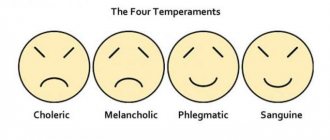Definition
Intention is a broad concept that can be described as the direction of thinking. The ability to think is born in every person in childhood. And it is at a young age that a child develops his own personal range of interests and a path to knowledge of the areas of interest to him. Under the influence of various internal and external factors, the baby forms his own picture of the world. He understands what is good and what is bad. Parents teach the child etiquette, competent speech and the basics of cultural behavior. By synthesizing this information, a person creates a base that he will use throughout his life. This basis is different for all people. You've probably encountered the problem that someone you know doesn't understand you, although it seems to you that you simply won't be able to explain it any more clearly. It may seem to you that the person opposite you is unimaginably stupid. But that's not true. Most likely, the direction of thinking between you and this person is very different. You look at the world differently and put different meanings into the same definition.
Types of intention
Like any broad concept, intention can be divided into several parts. What two types of thinking direction exist?
- Focus on the object. Under the influence of internal and external factors, a person develops his own picture of the world. Thanks to it, a person can reason, build ideas and guesses. It is the direction of thinking that shapes a person’s interests, culture of speech and culture of behavior.
- Goal orientation. The second type of intention is planning. To achieve something in life, a person must set goals and achieve them. Creating goals, building a plan to achieve them, making adjustments along the way - all these processes can be called intention.
Intention in philosophical discourse and in the Roman legal tradition
The term “intention” received its most complete development in the works of Aquinas , in which a distinction was made between the concepts of “intention” and “choice”.
These ideological attitudes are dominant in determining the direction of an act of will guided by practical reason.
For Roman lawyers, intention is an important component of the so-called formulary process.
This term denoted the main content of the document, which was built according to a special claim formula, which set out the essence of the accusation of the injured party against the defendant.
Intentional processes
All people think differently. One person likes to delve into the essence of the problem, another prefers to look at the problem in general, without going into details. What processes take place in a person’s brain when he directs his thinking to some object or goal.
- Emotionality. Emotions help a person understand whether he likes an object or object of contemplation or reflection. If you like it, then you can continue studying or communicating. If something is unpleasant to a person, he will try to get rid of the negative thought or the horrifying object of contemplation as soon as possible.
- Motivation. Intention is the direction of thinking. It would not exist if a person did not have motivation. The desire to see something, go somewhere and do something is the main thing in a person’s healthy life.
- Cognition. A person strives for knowledge, and it helps him to better understand this world and the people living in it. Books also form a worldview and a picture of the world. They help a person gain passive experience, without spending any resources other than temporary ones.
What is intention?
Intention is the conscious or unconscious direction (focus) of a person on a specific object or action. This manifests itself in the form of an intention, desire, plan, emotional impulse or simply a rash action, when a person performs an action, even if it is inappropriate, but corresponds to his internal needs.
Intention has many definitions:
- In psychology, it is a branch of logotherapy, which offers paradoxical intention - a way to get rid of fear or tension by maximizing its experience.
- In neurology, this is the focus of the psyche on a specific activity, object or goal achievement.
- In philosophy, this is a person’s orientation in understanding the world around him, which allows him to create his own unique idea of it.
- In linguistics, communicative intention is considered, which implies motives that prompt a person to say and express something.
Separately, there is also such a type of intention as dialogical - when the client becomes ready for dialogue in order to discuss the innermost. Here are its forms:
- Open clients who resist impulses that prevent them from communicating openly.
- Closed clients who may ask for help themselves, but are not ready for an open dialogue or show little interest.
Why don't wishes come true? The most common reason for this phenomenon is that a person takes from somewhere a good reason why his desire may not come true, and then begins to think about it more than about the desire itself. Even according to the law of attraction, a person attracts to himself what he thinks about. It turns out that if a person thinks about why his desire should not come true, then it will not come true.
How does this happen in practice? For example, a husband cheated on his wife, which caused the family to break up. A woman loves her husband, but cannot forgive him. She wants to be with him, but she constantly thinks in her head about why they can't be together. She loves and wants a family, but does not forgive, does not forget insults, and this is the reason why her desire does not come true.
For example, a person dreams of prosperity, but believes that this can only be achieved through hard work. He will not be able to achieve his goal because he does not want to do the only thing that, in his opinion, can bring him well-being - does not work. But if we consider prosperity independently, separately, without combining it with work that a person does not want to do, he will be able to attract his dream to himself. Only when a person begins to believe that he deserves prosperity just because he wants it will he attract it to himself.
Do you see how you can prevent the realization of what you want with your own beliefs and thoughts? This is due to the fact that each person has his own vision of the world and cause-and-effect relationships. One thinks that work can bring wealth, while the other simply believes that money will come to him just like that. And each of these people gets what they believe in: one works hard, and the other gets rich simply because he wants to. Don't contradict your desires with your own beliefs. Better change your beliefs and start believing that you are worthy of your desire simply because you want it so much. Let the Universe decide how it will become reality.
go to top
Where can you find intention?
- Psychology. In this science, intention is understood as the ability of an individual to replay some life situation in his head and, with the help of a second experience, get rid of fear. Various types of neuroses and phobias can be treated in this way.
- Neurology. Here intention is understood in the same way as in its standard definition - the direction of thinking. A person can, at his own request, switch his consciousness to studying his inner world, the external world, or set goals for himself and think through ways to realize them.
- Philosophy. Intention is understood as a focus on understanding one’s spiritual world and perceiving the surrounding reality. A person can know this world only when he can know himself perfectly.
Paradoxical
Psychotherapists use various techniques to alleviate the plight of their patients. One of these techniques is paradoxical intention. What is it? Every person has encountered a situation when he was very worried before the start of some event. For example, students are always worried before exams, and a person who goes for an interview for the first time worries about whether he will be able to make a good impression on the HR manager. This fear of the start of an event can lead a person to a state of panic. To relieve excessive nervousness, you need to specifically provoke the situation. An example of a paradoxical intention could be this: a person who is afraid to communicate with strangers should go out into the street and start a dialogue with everyone he meets. It doesn’t matter whether passers-by will carry on a conversation or limit themselves to a simple greeting. By provoking his fear, a person learns to overcome it. This method of paradoxical intention always works. It is used not only by psychologists, but also by ordinary people who want to overcome some kind of phobia.
Paradoxical intention
Viktor Frankl is an outstanding Austrian psychologist who went through the horrors of a Nazi concentration camp and, like no one else, successfully treated various kinds of phobias. Logotherapy, a branch of existential psychoanalysis founded by Frankl, included effective techniques for working with fears. Paradoxical intention is a method that has at its core a contradictory message or intention regarding the phobia. The patient experiencing fear was asked to want what he was so afraid of - the situation was worked out until a permanent relief from anxious feelings was secured.
Communicative
How do people communicate with each other? Through speech, they try to convey their thoughts to their interlocutor and reveal their inner world. Communicative intention is the direction of human thinking towards some goal. In order to find out the necessary information, a person can join the conversation, and in order to hide something, the interlocutor will try to discreetly change the topic. But people cannot always understand each other well. What's stopping this?
- Different meanings attached to concepts. When you communicate with a person, you hardly take into account the area where the interlocutor grew up, his moral values, education and upbringing. But all these factors make an individual unique. This is where the difficulty of communication lies. Sometimes two people can put different meanings into the same concept. Against this background, mutual misunderstanding arises.
- A different picture of the world. The direction of thinking is different for everyone. One person is interested in studying science, another is interested in studying art, and another is interested in studying politics. Accordingly, all these people will differ in their set of knowledge, skills and aspirations. Differences in views on the same things give rise to alienation and hostility.
- It's hard to understand something you haven't experienced. A person cannot always understand the state of his interlocutor. There are things that cannot be described in words, but can only be felt. For example, it is difficult to understand what the death of a loved one is until you have experienced this feeling.
Paradoxes in the science of psychology.
According to scientists, a person and his brain, consciousness, intellect, behavior are one complete paradox. We complain about the lack of money and use it to buy useless things. We are afraid of offending a stranger, but we tolerate humiliation from our relatives. We strive to be beautiful, but we don’t believe in compliments.
To study human behavior and thinking, famous psychologists of the 20th century created methods of paradoxical or provocative therapy . Non-standard techniques of intimidation, challenging the client, and provocation used during sessions do not reduce, but increase the psychological problem. They act on the principle of “knocking out fire with fire”: they intensify fear, help to live through it and close the topic. Provocative methods of therapy are considered indispensable in working with the most difficult cases.
Frankl's method of paradoxical intention.
The method formulated by Viktor Frankl is widely used today in the psychotherapy of neuroses and inappropriate behavior.
People with phobias, long-standing fears, fear the unwanted symptoms of their phobia. Agoraphobes are afraid of open spaces and do not go outside. The fear of water among those suffering from ablutophobia forces them to refuse bathing, washing their hands, and doing laundry. Trying to avoid an unpleasant situation or muffle unpleasant manifestations further aggravates the initial tension. The circle closes.
The essence of the paradoxical intention method is to convince a person with a phobia to imitate an unwanted reaction. This must be done consciously and always with humor. Do you suffer from insomnia? Try to fight sleep and stay awake as much as possible. Do you scream when you see a mouse? Imagine an animal and scream twice as loud. Give yourself the right to do something unacceptable. Personal involvement in the process will help break the neurotic circle.
Take a personality type test
Paradoxical theory of change in Gestalt therapy.
The paradoxical theory of change was formulated by the founder of Gestalt therapy, Fritz Perls. The theory became famous after the publication of Arnold Beisser.
The desire to become ideal or the way others want us to be leads to internal conflict. A person looking for change constantly rushes between “who he is” and “what he wants to be.” And it never becomes either one or the other. Therefore, many come to a therapy session with the goal of removing, “amputating” the problem. But the Gestalt therapist does not take on the role of a “secateur.” The therapist's goal is to help the client understand his true desires and learn to take care of himself.
The essence of the paradoxical theory of change is formulated as follows: a person begins to change when he becomes himself. Or in other words: change does not happen through a forced attempt to change oneself.
Sedona method or method of releasing emotions.
The Sedona method was developed by American producer Lestor Levenson, but it became famous thanks to the executive director of the training center, Gale Dvoskin. Gail Dvoskin described the method in his book “The Sedona Method” and since 1990 he has given lectures and trainings in America and Europe.
When faced with a traumatic situation, most people choose three ways to deal with negative emotions: suppression, expression, and avoidance. For example, after a painful breakup with a loved one, they brush off the suffering with “I’m fine.” If they fail at work, they go to a bar and drink until they pass out. Suppressed emotions accumulate, causing discomfort and physical illness. According to the author, the ideal role model is a child who falls to the ground, screams and kicks his feet. This way he is freed from unpleasant emotions. As we age, we care more about appearances than about emotional health.
The essence of the sedona method is to allow yourself to suffer to your heart's content, to suffer through all the negative emotions and thus cleanse yourself of them. Of course, you shouldn't fall on the floor in a store. But at home you can cry and grieve until there is no trace left of your worries.
Speech
Every statement a person makes, even unconsciously, carries some purpose. Speech intention is the birth of speech. Before speaking, a person must think, then form his thought into words and only then express it. Speech intention combines needs, motives and goals. With the help of the direction of thinking, a person can convey his knowledge to his interlocutor, share his problems, or learn something useful for himself. A dialogue can never become interesting if both participants do not make an effort to create it. It can manifest itself not only in a positive, but also in a negative form. For example, a person may express disapproval of some remark or action of his opponent.
Sample results
A cause for concern is the fact that the patient cannot draw a straight line from his finger to his nose. Instead of calmly hitting the target, the person begins to tremble, the movements become oscillatory, or right before the tip of the nose - the hand suddenly stops. As a result, the finger gets into the cheek, eyes, forehead or, generally, past the face.
The results of the finger-nose test may be as follows:
- Norm . The patient's condition is normal if he can calmly touch the tip of his nose with his eyes closed.
- Ataxia . A lot of useless movements and swings are made, which do not lead to a good result, but lead to missing the nose.
- Intention . As the finger approaches the nose, the hand spontaneously begins to tremble more and more.
- Symptom of bridle . Almost reaching the target, the finger suddenly stops. At this moment, the brain tries to determine the location of the hand in relation to the nose and navigate where to give direction next. Having understood what to do, the brain sends signals and the finger again moves to its destination.
In psychology
Extensions of intention are a concept that means a way of being that a person chooses. It is widely used in psychology. What does it apply to? Intention in psychology is the orientation of consciousness towards some object or object. Moreover, the fact of the real existence of the object is not so important. A person may be thinking about an imaginary problem. For example, it may occur to someone to think about how a person will live if monkeys take over the earth. In reality, humanity does not face such a threat, but someone may be terrified of it. By thinking about this topic and coming to the conclusion that life will be good, a person can ease his worries. Or a person can choose the place where she wants to spend her vacation. In this case, the person will carefully study the location of the hotel, its comfort, pricing policy and interesting attractions in the area. The direction of thinking will help you choose from all possible options one, the one that will suit you most.
Why do you need to study intention?
Studying psychology helps you better know yourself and others. And studying thinking, its basis and structure, and in the case of intention, its direction, is useful in order to better understand people. What manifestations of intention do you encounter every day? Have you noticed that some people often complain about their unsuccessful lives? Such people love to complain, to say that everything would be fine with them if it weren’t for this or that. Interlocutors sometimes do not understand that they live the way they want and deserve it. A successful person did not acquire his wealth immediately. He had to work hard to get a good education and a prestigious position in a growing company. Yes, in appearance it might seem that the person is not making any effort, but in fact the person is working hard. But many are accustomed to judging without knowing what is hidden behind the beautiful picture of success. Intention makes a person think about what kind of work it took for the individual to rise up. Thanks to such reflections, a person gets rid of envy and is inspired by the example of a successful person.










